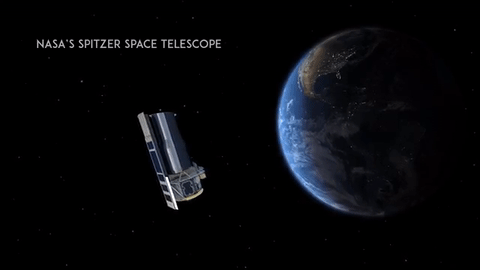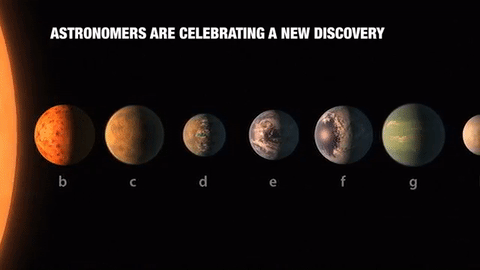Trappist - Blog Posts
Solar System: Things to Know This Week
Making every night science movie night with these amazing videos.

1. Pure Beauty
Our star sprouting coronal loops courtesy of the NASA sun team. See the full video: https://go.nasa.gov/2p47Lt2

2. Where’s the last place you'd expect to find enough ice to bury a city?
Answer: Mercury, the closest planet to the sun. Watch the video: https://svs.gsfc.nasa.gov/11184

3. The Mars Fleet
Only Earth has more satellites studying it. Full video: https://svs.gsfc.nasa.gov/4414

4. A Star-Studded Cast
Check out NASA's satellite fleet of Earth observers. See the video: https://svs.gsfc.nasa.gov/12586

5. Jupiter in Ultra HD
Thanks, Hubble Space Telescope! See the video: https://svs.gsfc.nasa.gov/12021

6. A Tear Jerker
Our Cassini spacecraft starts her 4.5-month Grand Finale this week. Full video: https://saturn.jpl.nasa.gov/resources/7628

7. Faster Than the Speed of Sound
Winds on Neptune travel faster than the speed of sound. Full video: https://svs.gsfc.nasa.gov/11349

8. A Musical Number
This one features the planet Uranus doing pop and lock. Full video: https://youtu.be/CWuWoiHmXUs

9. Up Close and Personal
Thanks to our New Horizons mission, we’ve been able to get up close and with Pluto. Full video: https://svs.gsfc.nasa.gov/12080

10: The Treasure Trove
TRAPPIST-1 is a treasure trove of seven Earth-sized planets orbiting a distant star. Full video: https://www.jpl.nasa.gov/video/details.php?id=1459
Discover more lists of 10 things to know about our solar system HERE.
Make sure to follow us on Tumblr for your regular dose of space: http://nasa.tumblr.com
Largest Batch of Earth-size, Habitable Zone Planets
Our Spitzer Space Telescope has revealed the first known system of seven Earth-size planets around a single star. Three of these planets are firmly located in an area called the habitable zone, where liquid water is most likely to exist on a rocky planet.

This exoplanet system is called TRAPPIST-1, named for The Transiting Planets and Planetesimals Small Telescope (TRAPPIST) in Chile. In May 2016, researchers using TRAPPIST announced they had discovered three planets in the system.

Assisted by several ground-based telescopes, Spitzer confirmed the existence of two of these planets and discovered five additional ones, increasing the number of known planets in the system to seven.

This is the FIRST time three terrestrial planets have been found in the habitable zone of a star, and this is the FIRST time we have been able to measure both the masses and the radius for habitable zone Earth-sized planets.
All of these seven planets could have liquid water, key to life as we know it, under the right atmospheric conditions, but the chances are highest with the three in the habitable zone.

At about 40 light-years (235 trillion miles) from Earth, the system of planets is relatively close to us, in the constellation Aquarius. Because they are located outside of our solar system, these planets are scientifically known as exoplanets. To clarify, exoplanets are planets outside our solar system that orbit a sun-like star.

In this animation, you can see the planets orbiting the star, with the green area representing the famous habitable zone, defined as the range of distance to the star for which an Earth-like planet is the most likely to harbor abundant liquid water on its surface. Planets e, f and g fall in the habitable zone of the star.
Using Spitzer data, the team precisely measured the sizes of the seven planets and developed first estimates of the masses of six of them. The mass of the seventh and farthest exoplanet has not yet been estimated.

For comparison…if our sun was the size of a basketball, the TRAPPIST-1 star would be the size of a golf ball.
Based on their densities, all of the TRAPPIST-1 planets are likely to be rocky. Further observations will not only help determine whether they are rich in water, but also possibly reveal whether any could have liquid water on their surfaces.
The sun at the center of this system is classified as an ultra-cool dwarf and is so cool that liquid water could survive on planets orbiting very close to it, closer than is possible on planets in our solar system. All seven of the TRAPPIST-1 planetary orbits are closer to their host star than Mercury is to our sun.

The planets also are very close to each other. How close? Well, if a person was standing on one of the planet’s surface, they could gaze up and potentially see geological features or clouds of neighboring worlds, which would sometimes appear larger than the moon in Earth’s sky.

The planets may also be tidally-locked to their star, which means the same side of the planet is always facing the star, therefore each side is either perpetual day or night. This could mean they have weather patterns totally unlike those on Earth, such as strong wind blowing from the day side to the night side, and extreme temperature changes.

Because most TRAPPIST-1 planets are likely to be rocky, and they are very close to one another, scientists view the Galilean moons of Jupiter – lo, Europa, Callisto, Ganymede – as good comparisons in our solar system. All of these moons are also tidally locked to Jupiter. The TRAPPIST-1 star is only slightly wider than Jupiter, yet much warmer.
How Did the Spitzer Space Telescope Detect this System?
Spitzer, an infrared telescope that trails Earth as it orbits the sun, was well-suited for studying TRAPPIST-1 because the star glows brightest in infrared light, whose wavelengths are longer than the eye can see. Spitzer is uniquely positioned in its orbit to observe enough crossing (aka transits) of the planets in front of the host star to reveal the complex architecture of the system.

Every time a planet passes by, or transits, a star, it blocks out some light. Spitzer measured the dips in light and based on how big the dip, you can determine the size of the planet. The timing of the transits tells you how long it takes for the planet to orbit the star.

The TRAPPIST-1 system provides one of the best opportunities in the next decade to study the atmospheres around Earth-size planets. Spitzer, Hubble and Kepler will help astronomers plan for follow-up studies using our upcoming James Webb Space Telescope, launching in 2018. With much greater sensitivity, Webb will be able to detect the chemical fingerprints of water, methane, oxygen, ozone and other components of a planet’s atmosphere.
At 40 light-years away, humans won’t be visiting this system in person anytime soon...that said...this poster can help us imagine what it would be like:

Make sure to follow us on Tumblr for your regular dose of space: http://nasa.tumblr.com
Webb Telescope Exposes TRAPPIST-1 c's Astonishing Atmosphere Revelation - In an exciting new discovery reported on June 19, 2023, Webb reveals an astonishing finding on exoplanet Trappist 1c. Read the full article here



James Webb Telescope to Reveal Secrets of Potentially Habitable Exoplanet Trappist-1e


Artist's conception of TRAPPIST-1 e, a potentially habitable exoplanet that orbits a nearby star. Credit: NASA
Trappist-1e is one of the seven exoplanets that orbit the ultra-cool dwarf star Trappist-1, which is located approximately 39.6 light-years away in the constellation Aquarius. Trappist-1e has been the subject of much interest among astronomers since it was discovered in 2017, as it is located within the habitable zone of its host star, making it a potentially habitable world. In this article, we will explore what we currently know about Trappist-1e and what the upcoming James Webb Space Telescope observations may reveal about this promising exoplanet. Read full article here
What Webb is Learning About Exoplanet Atmospheres
Observations from Webb are already providing unexpected findings. For instance, the results indicate that the atmospheres of gas giant planets around distant stars don’t necessarily follow the same trends we see in our own Solar System. Webb has also provided new insight into the Trappist-1 system, a stellar system that hosts Earth-sized planets. For the first time, Webb was able to obtain a thermal signature from the planet nearest the system’s host star.

Exciting news, James Webb Telescope publishes its first finding of Trappist 1 system.
In a new release published on March 27, 2023, James Webb Telescope measures temperature of rocky exoplanet TRAPPIST-1b. Full article here











OC paintings so far! They are all based on something space related!
Left to Right:
James Webb (JWST), Trappist (TRAPPIST-1), Spitzer (SST), Chandra (CXO), Discovery (Space Shuttle), Habex (HabEx concept), Lynx (Lynx concept) and Luvoir (LUVOIR concept)
I have more ocs I plan to paint! Hubble and Origins are on the top of my list right now. Hope some of you might be interested to see them!
I also like talking about my ocs so if you want, you can ask me questions about them, or talk to me about anything space related because I love space!